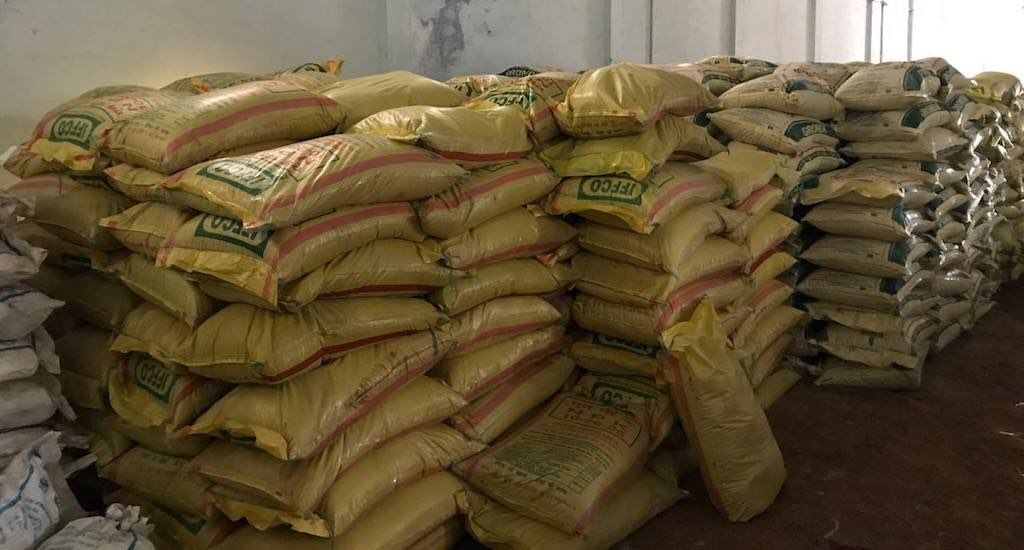How technology is streamlining supply chain of fertilisers in India
Bikalp Chamola

Thursday November 02, 2017 , 6 min Read
Linking technology and Aadhaar, the direct benefit transfer of fertiliser subsidy in Andhra Pradesh has helped curb malpractices and benefited farmers by preventing leakages.

As per the Union Budget of 2017, fertiliser subsidy, at 30 percent, is the second largest of all the subsidies the Government of India provides. Aadhaar-enabled Fertiliser Distribution System (AeFDS) is a direct benefit transfer (DBT) model aimed at streamlining the fertiliser supply chain and decreasing the burden on the exchequer. The project aims to improve soil health by curtailing overuse of fertilisers and reducing the input costs for farmers.
AeFDS was introduced in 2016 as a pilot scheme in 900 fertiliser retail outlets in Krishna district and 1,050 outlets in West Godavari district of Andhra Pradesh. The project is being implemented by the Government of India, to which Tata Trusts and a consortium of partners provide planning, strategic, and funding support.
Fertiliser subsidy
The fertiliser subsidy in the country is managed by the Department of Fertilisers, Government of India. It is an indirect subsidy, with the beneficiary paying a small portion of the product price and the government reimbursing the balance amount to the manufacturer.
Thus the subsidy is not credited to the beneficiary but to the manufacturer. The subsidy is released on the basis of the acknowledgement of the retailer on the sale of the fertiliser. Hence, the tendencies to inflate the cost of production and the number of beneficiaries have further burdened the State exchequer. AeFDS aims to eliminate the problem.
What started as an innovative idea by the collector of Krishna district with 20 small retailers was expanded to the whole district after recognisng its potential to create significant impact.
One of the first challenges to the scheme was the retailers’ apprehension. They apprehended the possibility of farmers procuring fertilisers from the adjacent district of West Godavari. This was a real risk likely to affect the pilot scheme and hence the scheme was introduced in West Godavari district as well.
The idea of selling fertilisers using an electronic device is very thrilling, Sudhakar of Rayanpadu village near Vijayawada told VillageSquare.
Hehas been working as a retailer selling fertilisers for over a decade, with a customer base of roughly 50 in and around his village.
Sudhakar’s excitement is due to the introduction of electronic
point of sale (ePos) devices for sale of fertiliser under the new AeFDS.
The machine confirms the identity of a farmer through the Aadhaar data base, retrieves land data from digitised land records, and links it to the farmer’s soil health card (SHC) recommendations.

SHC and fertiliser use
Farmers buy fertilisers from retailers, primary agricultural cooperative societies (PACS), or district cooperative marketing societies (DCMS). They use different combinations of fertilisers to minimise input cost and maximise yield.
The combinations also vary depending on whether the farmer is the owner or a sharecropper. A sharecropper would use less fertiliser or choose a less expensive one, as the impact of the fertiliser would be obvious only in the long run.
The SHC should ideally determine the amount of fertiliser to be sold to a farmer, thereby fulfilling the objective of the programme. At present, the SHC recommendations do not capture the seasonal variations in the nutrient composition of soil and hence are not of much value to the farmer. Some farmers have SHCs that are about four seasons old. Therefore, the sale of fertiliser remains the same, except for the availability of data on the quantity and type of fertiliser purchased by each farmer.
Elimination of malpractices
Most of us are sharecroppers. Earlier, some big players used to accumulate large quantities of fertilisers before we could mobilise enough money to buy them, Bhanu Pratap, a sharecropper, told VillageSquare.
Farmersin Kotikalapudi village of Krishna district told VillageSquare that tracking fertiliser sale using e-POS machines has brought down hoarding resorted to by large farmers.
The retailer has to now ensure that each of his customers has an Aadhaar card and is also in a position to pay cash upfront. Thus, the credit system for purchasing fertilisers has been eliminated, as credit rates were often high, besides fertiliser being used as collateral for credit.
In Krishna district, since the launch of the programme, there have been roughly 130 cancellations of the fertiliser retailer licences. Some of the reasons are that the inefficient ones or the ones engaged in black marketing earlier are now not able to continue the practice. Also, several aggregators who worked on a part-time basis as seasonal sellers do not want to adopt this method of selling.
Challenges
Even after AeFDS coming into effect, MRP has remained the same and hence the farmers see no impact with regard to price. The retailers still maintain a hard copy record of the fertiliser sale, as they are yet to have complete confidence in the machine.
The transaction time per customer has increased, especially due to network issues in rural areas. Sometimes this forces the retailer to sell the fertiliser manually; a habit that in the long run would prove detrimental to the manufacturers and hence wane away naturally.
In order to counter the issues pertaining to network signals, retailers have devised various ways to adjust. First, it is not always the owner who shows up for the purchase. In such cases, to authenticate identity, the ‘Other’ option is used on the machine and hence the retailer has to put in only the Aadhaar number of the owner, doing away with the use of fingerprint scanner.
Secondly, sale is clubbed in order to keep the farmer happy. Say, a farmer visits the outlet in the morning and the machine is not able to authenticate his identity due to poor network issues. The retailer sells it to him, especially small quantities, and clubs it with the purchase of the next farmer, when the network is strong enough to establish identity. Though this may misrepresent an individual farmer’s purchase, the government can keep track of the overall quantum of sale.
Weighing the odds
DBT in fertilisers has come at a good time, where small farmers can now access good-quality fertiliser without the fear of being cheated by unscrupulous retailers. The change does not cause any inconvenience to the farmers as the prices are the same as they were earlier.
The inefficient and seasonal retailers slowly move out, as they are reluctant to adopt technology.
Hoarders are now easily identifiable and therefore the practice of hoarding of fertilisers by large farmers is not feasible anymore.
Even though the transaction time per farmer has increased, retailers have devised ways, though temporary, to overcome the problem. Optimum usage of this model along with SHCs could lead to improvement of soil health. The idea of SHCs standardising fertiliser use needs to be worked upon.
While the challenges present in other DBT schemes are relevant to this model, this is an efficient way to tackle leakages in the fertiliser supply chain without causing much disturbance to the end user. Standard operating procedures for AeFDS under preparation would help the district administration and other stakeholders implement the DBT scheme effectively.
Disclaimer: This article, authored by Sasanka Kireeti and Bikalp Chamola, was first published in VillageSquare.in. The views expressed by the author are her own and do not necessarily reflect that of YourStory.








![[Product Roadmap] How Practo evolved from being a SaaS platform for doctors to a full-fledged healthcare ecosystem](https://images.yourstory.com/cs/2/a9efa9c02dd911e9adc52d913c55075e/product-road-map-1598948141466.png)

